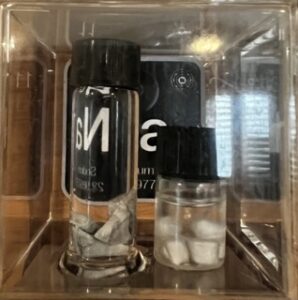Sodium
Atomic Number: 11
Atomic Mass: 22.989769 u

Sodium, a vital element, from the periodic table, is a metal that plays a critical role in both nature and human civilization. Whether it’s in our bodies, our homes, or the industries that power the global economy, sodium’s wide range of applications has made it indispensable. From its initial discovery to its everyday uses today, the story of sodium is one of science, innovation, and practicality.
Discovery
The discovery of sodium as an element dates back to the early 19th century. In 1807, Sir Humphry Davy, a British chemist, successfully isolated sodium for the first time. Davy, working at the Royal Institution of Great Britain in London, was using a method called electrolysis, which involves passing an electric current through a compound to break it down into its components. By electrolyzing molten sodium hydroxide (also known as caustic soda), Davy was able to isolate sodium as a pure metal. This groundbreaking experiment also led to the discovery of other elements like potassium and calcium, marking an important milestone in the advancement of chemistry.
Sir Humphry Davy’s method of isolating sodium from the periodic table not only demonstrated the power of electrolysis but also paved the way for further research into alkali metals. Sodium, named after the Latin word “soda,” has since been recognized as one of the most abundant elements in the Earth’s crust and essential to various biological and chemical processes.
Sodium’s Natural Occurrence
Sodium is a highly reactive metal, meaning that it rarely exists in its pure form in nature. Instead, it is commonly found in compounds, the most well-known being sodium chloride (NaCl), or table salt. Sodium chloride is abundantly found in seawater and has been used by humans for thousands of years, primarily as a food preservative and seasoning. In addition to salt, sodium can also be found in minerals like feldspar, rock salt, and soda ash.
Modern Day Uses of Sodium
Today, sodium, a vital element, from the periodic table plays a crucial role across a variety of industries and applications. Its versatility has made it an essential component in everyday products and complex industrial processes alike.
Table Salt and Food Preservation
Perhaps the most common use of sodium is in the form of sodium chloride, or table salt. Salt is a cornerstone of the human diet, essential for maintaining proper fluid balance and nerve function in the body. Beyond its dietary importance, sodium chloride has been used for centuries as a preservative, helping to preserve food by drawing moisture out and preventing bacterial growth. Even today, sodium remains a vital ingredient in food production and processing.
Chemical Industry
In the chemical industry, sodium compounds are used to produce a wide array of products. For example, sodium hydroxide (NaOH), also known as lye or caustic soda, is a highly alkaline substance used in the manufacturing of soap, paper, textiles, and detergents. Sodium carbonate (Na2CO3), known as soda ash, is another important compound used in the glass-making process and in the production of detergents and cleaning agents.
Medicine and Healthcare
In healthcare, sodium is an essential component in intravenous (IV) fluids and electrolyte replacements. Sodium chloride solutions are administered to patients to maintain proper hydration and electrolyte balance, especially during surgery, illness, or dehydration. Additionally, sodium bicarbonate (baking soda) is used as an antacid to relieve heartburn and indigestion.
Energy Storage
In recent years, sodium has gained attention in the field of energy storage. While lithium-ion batteries are currently the most popular choice for storing energy in everything from smartphones to electric vehicles, sodium-ion batteries are being explored as a more sustainable and cost-effective alternative. As Sodium is abundant and cheaper to source than lithium, making sodium-ion batteries a promising option for large-scale energy storage systems, particularly for renewable energy sources like solar and wind.
Sodium Vapor Lamps
Sodium vapor lamps, commonly used in street lighting and industrial areas, emit a characteristic yellow-orange light. These lamps are energy-efficient and have been used for decades to light roads, bridges, and public spaces. Although they are gradually being replaced by LED lighting, sodium vapor lamps remain in use in many parts of the world due to their reliability and cost-effectiveness.
Water Softening
Sodium plays a key role in water softening, a process that removes calcium and magnesium ions from hard water, preventing scale buildup in pipes and appliances. Sodium-based water softeners replace the hard minerals with sodium ions, which do not form scale. This technology extends the lifespan of plumbing systems and improves the efficiency of household appliances like water heaters and dishwashers.
The Future of Sodium
As scientists continue to explore new uses for sodium, a vital element, from the periodic table, its role in modern technology and sustainability will likely expand. Sodium-ion batteries, for example, hold the potential to revolutionize energy storage, offering a more affordable and environmentally friendly alternative to lithium-based systems. With the increasing demand for clean energy solutions and efficient industrial processes, sodium’s applications will continue to evolve.
Conclusion
Sodium, from its discovery by Sir Humphry Davy in the early 1800s to its widespread use today, is an element with extraordinary importance. Whether it’s in the form of common table salt or cutting-edge battery technology, sodium from the periodic table of elements remains a vital part of both everyday life and industrial innovation. As we look to the future, sodium’s versatility ensures that it will continue to play a significant role in addressing some of the world’s most pressing challenges.
 using WordPress and
using WordPress and
No responses yet